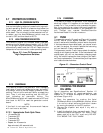
Generac
®
Power Systems, Inc. 9
NOTE:
Your generator is equipped with a battery trickle
charger that is active when your unit is set up for
automatic operation. With the battery installed
and utility power source voltage available to the
transfer switch, the battery receives a trickle
charge while the engine is not running, to prevent
self-discharge. The trickle charger is designed to
help extend the life of your battery by maintaining
the battery when the unit is not running. The
trickle charge feature cannot be used to recharge
a discharged battery.
1.11 THE BATTERY
Servicing of the battery is to be performed or super-
vised by personnel knowledgeable of batteries and
the required precautions. Keep unauthorized person-
nel away from batteries.
When replacing the battery, use the following type of
battery: Group 26/26R 12-volt battery with a rating of
350 cold-cranking amps minimum for 7 kW; 550
cold-cranking amps minimum for 12 and 15 kW at -
17.8º C (0º F) minimum. When using a maintenance-
free battery, it is not necessary to check the specific
gravity or electrolyte level. Have these procedures
performed at the intervals specified in the “Service
Schedule.” A negative ground system is used. Battery
connections are shown on the wiring diagrams. Make
sure the battery is correctly connected and terminals
are tight. Observe battery polarity when connecting
the battery to the generator set.
Do not dispose of the battery in a fire. The
battery is capable of exploding.
A battery presents a risk of electrical shock
and high short circuit current. The following
precautions are to be observed when working
on batteries:
• Remove watches, rings or other metal objects;
• Use tools with insulated handles;
• Wear rubber gloves and boots;
• Do not lay tools or metal parts on top of the
battery; and
• Disconnect charging source prior to connecting or dis-
connecting battery terminals.
Do not open or mutilate the battery. Released
electrolyte has been known to be harmful to
the skin and eyes, and to be toxic.
The electrolyte is a dilute sulfuric acid that is
harmful to the skin and eyes. It is electrically
conductive and corrosive.
The following procedures are to be observed:
• Wear full eye protection and protective clothing;
• Where electrolyte contacts the skin, wash it off
immediately with water;
• Where electrolyte contacts the eyes, flush
thoroughly and immediately with water and seek
medical attention; and
• Spilled electrolyte is to be washed down with an
acid neutralizing agent. A common practice is to
use a solution of 1 pound (500 grams) bicarbonate
of soda to 1 gallon (4 liters) or water. The bicar-
bonate of soda solution is to be added until the
evidence of reaction (foaming) has ceased. The
resulting liquid is to be flushed with water and the
area dried.
Lead-acid batteries present a risk of fire
because they generate hydrogen gas. The
following procedures are to be followed:
• DO NOT SMOKE when near the battery;
• DO NOT cause flame or spark in battery area; and
• Discharge static electricity from your body before
touching the battery by first touching a grounded
metal surface.
Be sure the Auto/Off/Manual switch is set to
the OFF position before connecting the battery
cables. If the switch is set to AUTO or MANUAL,
the generator can crank and start as soon as
the battery cables are connected.
Be sure the utility power supply is turned off,
or sparking may occur at the battery posts as
you attach the cables and cause an explosion.
2.1 BEFORE INITIAL START-UP
Before starting, complete the following:
1. Set the generator's Auto/Off/Manual switch to the
OFF position.
2. Turn OFF the utility power supply to the transfer
switch using the means provided (such as the
utility main line circuit breaker).
3. Check the engine crankcase oil level and, if nec-
essary, fill to the dipstick FULL mark with the
recommended oil. Do not fill above the FULL
mark.
4. Check the fuel supply. Gaseous fuel lines must
have been properly purged and leak tested in
accordance with applicable fuel-gas codes. All
fuel shutoff valves in the fuel supply lines must be
open.
Never operate the engine with the oil level
below the “Add” mark on the dipstick. Doing
this could damage the engine.
!
!
!
!
DANGER
Section 2 — Post Installation Start-up and Adjustments
Guardian Air-cooled 7 kW, 12 kW and 15 kW Generators


















